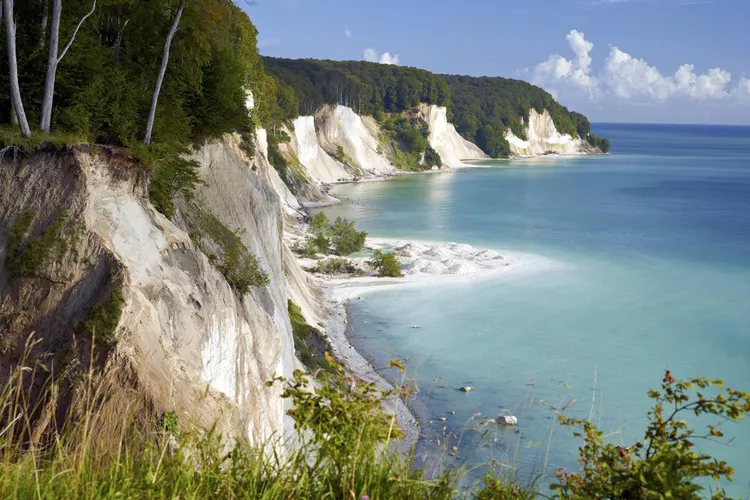Guide to Germany’s Largest Island
Rügen, Germany’s largest island, is located in the northeast of the country off the Baltic Sea. Rügen has been one of Germany’s most popular travel destinations for centuries; notable figures like Bismarck, Sigmund Freud, Thomas Mann, and even Albert Einstein have vacationed here. During the GDR, the island became favored by top politicians, including Erich Honecker.
Once known for its quiet fishing villages, Rügen is famous for romantic seaside resorts and spas dating back to the 18th century, combined with spectacular landscapes. The coast offers mile-long beaches, many historically known for their clothing-optional policies. Towering above the sandy shores are the striking chalk-white cliffs, Kreidefelsen, which are a major draw for visitors.
The heart of the island features a scenic drive along Alleenstrasse, which is lined with centuries-old trees on cobblestone avenues. Alternatively, explore the island on the Rasender Roland (Racing Roland), a historic steam train connecting various towns and seaside resorts.
Beaches of Rügen

Miles of pristine beaches, many exceeding 130 feet in width, make Rügen a sought-after summer destination for both Germans and international travelers. Water sports enthusiasts are also drawn to Rügen, with surfing, kiting, and sailing being particularly popular.
Notably, many beaches in Rügen are designated as nude beaches (look for the FKK signs). For a map of Rügen’s family-friendly nude beaches, you can visit the Rügen Tourism Website.
National Park on Jasmund Peninsula

The Nationalpark Jasmund is the smallest national park in Germany, yet its breathtaking snow-white chalk cliffs, Kreidefelsen, are a major attraction. The towering Königsstuhl rises 118 meters directly from the Baltic Sea.
Founded in 1990—just prior to reunification—these cliffs were made famous by Germany’s Romantic painter Caspar David Friedrich, and they remain a UNESCO World Heritage Site.
For unforgettable views of these majestic cliffs, consider taking a boat tour around the peninsula, where the perspective from the water is truly spectacular.
Hiddensee

This charming little island, located west of Rügen, is car-free; movement is restricted to bicycles, horse-drawn carriages, or by foot—providing the ultimate escape from urban life.
Large portions of Hiddensee are designated as nature conservation areas, ensuring an abundance of unique flora and fauna among the island’s 1,300 permanent residents. Cranes, mussels, and migratory birds abound.
With rugged cliffs, pristine sandy beaches, salt marshes, and quaint fishing villages, Hiddensee offers an ideal refuge from the hectic pace of mainland life.
Sellin

Sellin is a stunning seaside resort adorned with elegant architecture dating back to the early 19th century. Many villas and hotels showcase Art Nouveau elements, including turrets, steeples, and wooden loggias.
Highlighting Sellin’s charm is its historic reconstructed seebrücke (pier) from 1901. This longest pier on the island features a restaurant over the water and includes a tauchgondel (diving gondola).
Other notable resort towns in the area include Lauterbach, Putbus, Binz, and Göhren.
Kap Arkona

The northernmost tip of Rügen, Kap Arkona, is famous for its picturesque lighthouses. Among these, the Leuchtturm Kap Arkona, constructed by Friedrich Schinkel in 1826, is the oldest lighthouse on the Baltic Sea coast. The lighthouse now hosts a museum dedicated to lighthouses and maritime rescue efforts, featuring an observation platform with stunning sea views extending to the Danish island of Møn.
Additionally, the area boasts the charming fishing village of Vitt, alongside the remnants of a Slavic castle that was overtaken and destroyed by the Danes in 1168.
Sanddorn

Sanddorn, or sea buckthorn, is an orange berry not widely recognized outside Europe, yet it is a Rügen specialty thriving in the island’s sandy dunes. Notably, it contains 15 times more Vitamin C than an orange.
Look for local Sanddorn products like jams, honey, juices, oils, and fruit wine. Sampling these offerings makes for delightful treasures to take home as unique souvenirs.
Stralsund

Hanseatic Stralsund often serves as a gateway to Rügen (or Tor zur Insel Rügen auf Deutsch), yet it boasts numerous attractions. Once part of a Swedish administrative region, the town’s design reflects local brick architecture alongside influences from its Nordic neighbors.
Before heading to the island, consider exploring the attractions in this seaside town, including its beautiful harbor, aquarium, and the historic altstadt (old town).





